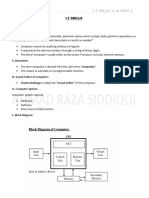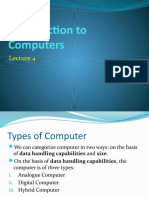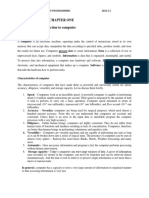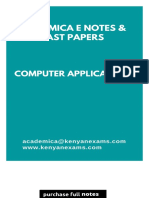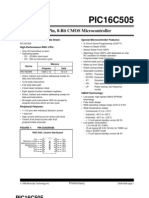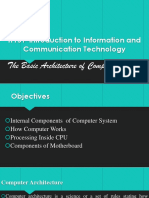UNIT Ichapter1 (Introduction To Computer)
Uploaded by
Vinutha SanthoshUNIT Ichapter1 (Introduction To Computer)
Uploaded by
Vinutha SanthoshUNIT I
INTRODUCTION TO COMPUTER
1.0 INTRODUCTION
Computers are fact of life. Whatever you do, wherever you go, you will encounter a
computer or computer- delivered services- every day. Computers have become so
commonplace that most people don’t even, think about their roles or functions any more.
What is a computer?
A computer is an electronic machine that operates under the control of a set of instructions. It
is a tool for accomplishing the data processing functions. It processes data & delivers y in
large volumes, efficiently, and at relatively low cost.
Computer performs its actions according to the instructions that are given to it. Thus we can
control the activities of a computer according to the instructions that are supplied to it. The
set of sequenced instructions that are supplied to the computer to perform a particular
operations is called as a program.
Computer works by accepting data from an input device and processes them according to the
given instructions into useful informations. It then displays the results of operations on an
output device.
A computer may be defined as an electronic machine that can solve problems by
accepting data, performing certain operations and presenting the results of those
operations under the directions of detailed step- by step instructions.
When dealing with computers we often encounter a word “ data”. What is data? Data is a
collection of facts, figures or statistics, which can be processed to produce meaningful
informations. Data on its own has no meaning. We need to interpret the data to get the useful
information.
Eg: a number such as 02332 could be a register number of a student or a hall ticket no of a
student. Individually it does not represent any meaningful information, it just represents a
fact, such representation are called as DATA.
DATA INFORMATION
Data is a collection of facts, figures or Information is a processed data with a
statistics which can be processed to produce definite meaning.
meaningful information.
Data is the basic element in any data Information is a structured data.
processing activity
Without proper identification data will not Information provides a clear meaningful for a
reveal anything collection of data.
4SEM BBA/COMPUTER APPLICATIONS IN MANAGEMENT/CHAPTER 1:INTRODUCTION COMPUTER Page 1
q)write a note/types of computer/classification.
1.1 TYPES OF COMPUTERS:
The computer can be classified in different ways. Usual classification are:
1. Based on their constructions and working
2. Based on application
3. Based on size speed and working.
1. Classification based on construction and working.
Based on the operating principles, computers can be classified into one of the following
type.
a. Analog computers: these computers are used to monitor continuously changing
signals, such as variation of temperature and pressure in chemical plant. They assign
numeric values to the physically measured property, such as the length of an object,
an angle created by two lines, or the amount of voltage passing through a point in an
electric circuit. Analog computers device all their data from some form of
measurement. The accuracy of the data used in an analog computers is directly related
to the precision of its measurement.
Eg: a petrol service stations pump contains an analog processor that converts fuel
flow measurements into quantity and price values.
b. Digital computers: these computers can accept discrete data such as digits and other
symbols, process them and give output in a human readable form. Unlike the analog
computers, which is limited to the accuracy of the measurements made the digital
computers can accurately represent data using as many positions and numbers as
necessary. They are used in common application such as solving simultaneously
equations etc.
c. Hybrid computers: hybrid computers combine the best features of analog and digital
computers. They have the speed of analog computers and the accuracy of digital
computers. They are usually used for special problems in which input data is
delivered from the measurements and converted into digits. These digital data is then
processed by computers.
Eg: in aviation to control national defence and passenger flight radar, in intensive care
unit of hospital etc..
2. Classification based on applications
Based on the application computers are classified as:
a. General purpose computers: these are designed to meet the needs of many
different applications. In these computers the instructions needed to perform a
particular task are not wired permanently into the internal memory. Thus new
instructions can be loaded as and when required for processing. General purpose
computers can store large amounts of data and the programs necessary to process
4SEM BBA/COMPUTER APPLICATIONS IN MANAGEMENT/CHAPTER 1:INTRODUCTION COMPUTER Page 2
them. As they are versatile, they are mostly used in businesses applications such
as preparation of pay bill, manage inventories, print sales report etc.
b. Special purpose computers: these computers are dedicated to cater the
requirement of a particular task or application. These do not posses unnecessary
options and thus costs less. Special purpose computers may be designed to process
only numeric data or to completely control automated manufacturing processes.
Eg: computers that are built into high end digital camera, automobile fuel and
ignition control etc.
3. Classification based on size, speed and capability:
Based on size, speed and capability to handle volume of data, computers can be
classified into one of the following types.
1. Supercomputers: these are the fastest and largest computers available today.
They are powerful machines with extremely large storage capacities and
computing power. They can process up to a billion instructions per second.
They are used in applications involving large scale mathematical calculations
on large volumes of data.
To support the extremely high computational speed of CPU’ rapid retrieval of stored data and
instructions is required. Therefore, in addition to large storage capacity, the super computers
have a very fast input- output capability. Most supercomputers have two characteristics in
common.1. parallel processing, 2. Fault tolerant. Unlike conventional computers, which have
a single processor which processes one instruction at a time, supercomputers have multiple
processors ( or CPUs) that process multiple instruction at a time. This technique is known as
parallel processing. some business application such as image processing, graphics, and
financial portfolio analysis require this kind of parallel processing. since these processors
work at extremely high speed, they are kept inside a liquid coolant so as to prevent them from
getting overheated and eventually melt- down.
Super computers are fault- tolerant. They use a backup mechanism to automatically isolate
and reconfigure hardware that fails during the system operation. They are usually used in
research and weather forecast etc.
2.Main frame computers: The largest type of computer in common use is the mainframe.
Mainframe computers are used in large organizations like insurance companies and banks
where many people need frequent access to the same data, which is usually organized into
one or more huge data bases. Airlines use large mainframe systems for flight scheduling,
reservations, ticketing, and meeting a range of customer service needs. Government agencies
such as the Internal Revenue Service, Federal Aviation Administration, and the Census
Bureau-use mainframes to track information about large populations, individual tax records,
payroll, and more. Many large grocery and retail chains interconnect their stores with a
mainframe, which immediately registers every sale, oversees stock, and manages inventory
levels. Mainframes are being used more and more as specialized servers on the World Wide
Web, enabling companies to offer secure transactions with customers over the Internet. The
4SEM BBA/COMPUTER APPLICATIONS IN MANAGEMENT/CHAPTER 1:INTRODUCTION COMPUTER Page 3
mainframe system may be referred to as an enterprise server or E-commerce server. In a
traditional mainframe environment, each user works at a computer terminal. A terminal is a
monitor and a keyboard wired to the mainframe. There are basically two types of terminals
used with mainframe systems. A dumb terminal does not have its own CPU or storage
devices. Each dumb terminal is simply an input/output (I/O) device that functions as a
window into a computer located some where else. An intelligent terminal, on the other hand,
has its own processor and can perform some processing operations.
Many enterprises are now connecting personal computers and personal computer networks to
their mainframe systems. This connection gives users access to mainframe data and services
and also enables them to take advantage of local storage and processing. A mainframe system
can house an enormous volume of data, containing literally billions of records.
3.MINICOMPUTERS: Minicomputers got their name because of their small size compared to
other computers of the day. The capabilities of a minicomputer are somewhere between
mainframes and personal computers. Like main- frames, minicomputers can handle much
more input and output than personal computers. Although some "minis" are designed for a
single user, most are designed to handle multiple terminals. The most powerful
minicomputers can serve the input and output needs of hundreds of users at a time. Dozens or
hundreds of personal computers can be connected to a network with a minicomputer acting as
a server. Like mainframes, midrange computers are used more and more as Web servers,
handling thousands of transactions per day. Single-user minicomputers are commonly applied
to sophisticated design tasks, such as animation and video editing.
4.WORKSTATIONS : Somewhere between multi-user midrange computers (minicomputers) and
personal computers are workstations. Workstations are specialized, single-user computers
with many of the features of a personal computer but with the processing power of a
minicomputer. These powerful machines are popular among scientists, engineers, graphic
artists, animators, and programmers-users who need a great deal of number-crunching power.
Workstations typically use advanced processors and feature more RAM and storage capacity
than personal computers. Workstations often have large, high-resolution monitors and
accelerated graphics-handling capabilities, making them perfect for advanced design,
modeling, animation, and video editing. Although workstations are often found in single-user
applications, they are more and more often used as servers on personal computer networks
and as Web servers.
5. MICROCOMPUTERS OR PERSONAL COMPUTERS (PC)
Different models in PC
-Desktop Models
The first style of personal computer introduced was the desktop model. In common usage,
the term desktop system means a full-size computer that is small enough to be used at a desk
but too big to carry around. Traditionally, a desktop computer's main case( ie the CPU unit) is
horizontally oriented, meaning it can lie flat on a desk or table.Tower models have become
increasingly popular in recent years-so much so that some PC makers have stopped offering
horizontally oriented desktop systems.
A variation of the desktop system is the tower model, where the system unit sits vertically
and has more space for devices. Because of its design, the system unit is often placed on the
4SEM BBA/COMPUTER APPLICATIONS IN MANAGEMENT/CHAPTER 1:INTRODUCTION COMPUTER Page 4
floor to preserve desk space, allowing more room to place external components, such as
removable disk drives or scanners, on the desktop.
-Notebook Computers or Laptop Computer
Notebook computers, as their name implies, approximate the shape of an 8.5 by 11 inch
notebook and can fit inside a briefcase easily. Also called laptop computers, they can operate
on alternating (plug-in) current or special batteries. Notebooks are fully functional
microcomputers; the people who use them need the power of a full-size PC wherever they go.
Some notebook systems are designed to be plugged into a docking station (also called an
expansion base) which may include a large monitor, a full-size keyboard and mouse, or other
devices such as an additional hard drive or backup tape unit. Docking stations also provide
additional ports that enable the notebook computer to be connected to different devices in the
same manner as a desk- top system. Some expansion bases also feature built-in networking
cards so one is not required in the note book computer.
-Network Computer (NC)
In some situations, a user does not need all the power and features provided by a personal
computer. If you want to use only the Internet, for example, or if your job involves data entry,
then you may not need the processing power, memory, and storage capacity of a fully
equipped Pc. In this instance a network computer (NC) becomes useful. A network computer
is a less powerful version of a personal computer, with minimal processing power, memory,
and storage. Network computers are designed to be connected to a network, a corporate
intranet, or to the Internet. The NC relies on the network for software and data storage and
may even use the network's server to perform some job processing tasks. Many large
companies have adopted network computers for their users because they have a lower total
cost of ownership (TCO) than standard personal computers. NCs are cheaper to purchase,
operate, and maintain than normal PCs. Because most users' systems are connected to a
company network anyway, users can take advantage of the network server's speed and
storage capacity and can often access the Internet through the company's network
connection.
-Handheld Personal Computers (H/PCs): A handheld PC can be any sort of computer that
fits in the user's hand, such as Personal Digital Assistants (PDAs). Cellular Phones. H/PC has
small displays and keyboards, but are much smaller than even the tiniest full-featured
notebook Pc. This type of H/PC is sometimes called a mini-notebook computer. Most H/PC
systems do not provide disks, but memory can be added through PC cards or other means.
Software is abundant for these devices, most of which are Internet-capable and can connect to
a full-size computer to exchange data.Personal digital assistants (PDAs) are among the
smallest of portable computers. Often, they are no larger than a small appointment book, but
they are much less powerful than notebook or desktop computers. PDAs are normally used
for special applications, such as taking notes, displaying telephone numbers and addresses,
and keeping track of dates or agendas. Many PDAs can be connected to larger computers to
exchange data. Most PDAs come with an electronic pen that lets the user write on a touch-
sensitive screen. Even though they do not include real keyboards, some of these devices
4SEM BBA/COMPUTER APPLICATIONS IN MANAGEMENT/CHAPTER 1:INTRODUCTION COMPUTER Page 5
provide a graphical keyboard that appears on the screen you type by tapping the desired keys
with the unit's pen.
Cellular Phones Some new cellular phones are doubling as miniature PCs. Advanced
cellular devices combine analog and digital cell-phone service with e-mail capabilities. Such
phones enable the user to check and send e-mail and faxes over the phone. They offer
features no normally found on a phone, such as personal organizers or access to the Web.
Some models even break in half to reveal a miniature keyboard.
q)Discuss the characteristics of computer in details
1.2 CHARACTERISTICS OF COMPUTER:
All computers, regardless of size, cost, and use, have some basic characteristics. Some of the
important characteristics of a computer are summarized below.
Speed:
Computers can perform arithmetic operations and manipulate informations at phenomenal
speeds. The speed of a computer is closely related to the amount of data it can process. It is
measured as numbers of instructions executed in one second. Usually a computer can execute
million instructions per second (MIPS).
Accuracy:
In spite of high speed, computers rarely make mistakes and can accurately perform all kinds
of complex computations, thereby providing accurate as well as consistent information.
Errors do occur in computer based information systems, but these errors are due to program
logic error erroneous data or due to human errors.
Reliability:
computers are adept at repetitive tasks and never get tired of repetitive calculations. Unlike
humans they are capable of operating under the most adverse conditions for extended periods
of time. Computers consistently provide the same accurate results under all operating
conditions.
Storage capability: computers can store large volumes of data and instantly retrieve/
manipulate the stored data at any time.
Reduced cost: cost of computers and peripherals have dropped drastically over the years and
their use in organizations is found to reduce the operating cost of the organization. Thus using
computers are cost effective.
Intangible benefits: companies can utilize computers for intangible benefits. For eg: a
business organization can provide service to it customers even after the regular office hours.
Thus the computers provide flexibility and ability to accommodate growth to an organization.
Thereby providing competitive edge to the organization over its competitors.
q)Explain the components of a computer with a block diagram.
4SEM BBA/COMPUTER APPLICATIONS IN MANAGEMENT/CHAPTER 1:INTRODUCTION COMPUTER Page 6
1.3 COMPONENTS OF COMPUTER
Computer systems are built from many components. The components of a computer that
accept instructions and data are called input devices or input units. The part of a computer
which stores information in the form of instructions and data is named as memory unit. The
processing of data is done by the central processing unit abbreviated as (CPU) and is called as
heart and nerve centre of the computer. Finally the devices communicating the results to the
user are called output devices or output units. Thus essentially a computer consists of the
following three main units: Although specific systems differ, certain basic components or
building blocks exist in all computer systems. They are:
1. Input unit
2. Memory unit
3. Central processing unit (CPU)
- Arithmetic and logical unit (ALU)
- Control unit ( CU)
4. Output unit.
1.INPUT UNIT: data is entered into the computer system by means of an input device.
The keyboard is one of the most common input devices. Other common input device
include magnetic tape, magnetic disk, light pen, mouse, optical scanners, MICR
( magnetic ink character recognitions), Bar code readers and OCR (optical character
recognition). There are also unsual input devices that respond to voices and to touch. On
touch- sensitive screens, the user simply touches the locations on the screen where the
description of the desired operation is displayed; the computers sense where the screen
has been touched and performs the indicated operations.
In order to process the details of each command by the computer system, the command
will have to be converted into a machine readable format and this is done through the
input unit. This unit will transmit the data as a series of electrical pulses into the
computers memory unit where it will be available for processing. the input device
translate the data into a code that can read by the computer systems electronic circuitry.
2.MEMORY UNIT: the function of the memory unit is to receive, store and deliver data
or instructions. There are two types of memory devices that are usually used in the
computers. They are called as primary memory and secondary memory. The primary
memory or the main memory stores the program/ data during execution and is capable of
operating at electronic speeds. Secondary memories are large and cheaper than primary
memories. They are slower than the primary memories and are usually used to store
archival information. A wide range of devices such as magnetic disk/ tapes, drums, hard
disk, CD-ROMS and floppy disks are available for secondary storage.
3.CENTRAL PROCESSING UNIT:the central processing unit acts as the brain of the
computer. It contains the electronic circuitry that actually processes the data according to
the given instructions. The CPU also controls the flow of data through the system,
4SEM BBA/COMPUTER APPLICATIONS IN MANAGEMENT/CHAPTER 1:INTRODUCTION COMPUTER Page 7
directing the data to enter the system placing data in memory and retrieving them when
needed, and directing the output of information. The CPU consists of two sub units,
namely ALU and CU.
arithmetic logic unit (ALU): the arithmetic logic unit performs all the processing these
include arithmetic operations such as addition, subtraction, multiplication etc and logical
operations such as AND, OR, XORTEC. Logical operations help in taking logical
decisions.
Control unit(cu): this unit coordinates the activities of all the other units in the system. It
performs the following functions:
- it can get instructions out of the memory unit.
- It can decode the instructions.
- It initiates appropriate actions by arithmetic unit.
- It routes the data to the correct place at the correct time.
- It determines the next instruction that needs to be executed, after the execution of
previous instructions.
4.OUTPUT UNIT: main function of output device is to receive information from the
CPU and present it to the user in the desired form. The output device translates processed
data from a machine- coded form to a form that can be read and used by people. The most
common types of output devices are the monitor, which resembles a television screen,
and the printer, which prints copy from the computer onto paper, magnetic tape, magnetic
disk and floppy diskette. Another common output device is the graphics plotter, which
produces graphs, charts, or technical drawing on paper. The output seen on the monitor is
called soft copy and printout obtained by the printer is called hard copy.
A new type of output device being developed now is the speech synthesizer, a mechanism
attached to the computer that produces verbal output sounding almost like human speech.
A block diagram showing the functional units of a computer is shown below.
CPU
4SEM BBA/COMPUTER APPLICATIONS IN MANAGEMENT/CHAPTER 1:INTRODUCTION COMPUTER Page 8
Arithmetic & logic
unit (ALU)
Input Unit Output Unit
Control Unit (CU)
Main Memory
( primary storage)
Secondary
Memory
1.4 COMPUTER SOFTWARE CLASSIFICATION:
Software is basically the set of instructions grouped into programs that make the electronic
devices in the computer to function in the desired ways. The different categories of software
are:
1. System software
2. Application software
q) Explain in brief about system software.
q) What is software? Explain in detail of system software.
1.System software: programs that control and direct the operation of the computer
hardware are system software. For example, system software controls the saving of data
and its retrieval from secondary storage devices. The system software includes the
following:
a. Operating system:
An operating system is a set of programs that controls and supervises a computer
systems hardware and provides services to programmers and users of a computer
system. Its purpose is to manage the hardware for the most efficient use of
computer resources and to provide an interface between a user or an application
programs and the hardware. Examples: disk operating system (DOS), UNIX etc.
b. Operating environment & shells:
These are software programs that run top of the operating system, and act as a
homogenous user interface between the applications and the operating system.
4SEM BBA/COMPUTER APPLICATIONS IN MANAGEMENT/CHAPTER 1:INTRODUCTION COMPUTER Page 9
They provide more facilities for input/output than the operating system. Eg:
Microsoft windows on DOS, X- Windows for Unix etc.
c. Device drivers:
These are special programs to extend the capabilities of operating systems in order
to support more input/ output devices like mouse, scanners, printers etc.
d. Disk directory & file management utilities:
These are utility programs generated to manage data. These programs provide a
good user- interface to ease the process of maintaining the files, directories and
other system related settings.
q)Explain in details regarding application software.
Application software:
Application software is written to enable the computer to solve specific data processing task.
There are two categories of application software.
a. Paper- written application packages
b. User written application and packages.
a.Pre- written application packages(open-ended software): a number of powerful
application software packages, which does not require significant programming knowledge,
have been developed. These are easy to learn and use as compared to the programming
languages. The most important categories of pre written application packages available are:
- data base management software
- spreadsheet software
- word processing, desktop publishing (dtp) and presentation software
-graphics software
- data communication software
-statistical and operational research software.
b.User written application packages: user written application packages are those that are
designed and coded using some of the application packages or a programming language to
perform a specific task. Foe eg: payroll program and inventory control program for specific
organization etc.
q)Explain functions regarding operating system.
1.5 FUNCTIONS OF OPERATING SYSTEM
4SEM BBA/COMPUTER APPLICATIONS IN MANAGEMENT/CHAPTER 1:INTRODUCTION COMPUTER Page 10
An operating system is a program that controls the execution of application programs and
acts as an interface between the user of a computer hardware. An operating system mainly
performs the following functions:
1. Convenience: it makes computer more convienient to use
2. Efficiency: it allows the computer system resources to be used in an efficient manner.
3. Provides the instruction to display the on screen elements with which you interface
collectively these elements are known as the user interface.
4. OS load’s programs (such as word processing and spread sheet programs) into the
computer’s memory so that you can use them.
5. OS Co-ordinates how programs work with the C.P.U, RAM, Keyboard, mouse,
printer, and other hardware as well as with other software.
6. Manages the way information is stored on and retrieved from disk.
The operating system typically provides services in the following areas.
1. Program creation:
OS services editors and debugging to assist the programmers in creating programs.
These services are in the form of utility programs that are accessible through the OS.
2. Program execution:
This needs instructions and data to be loaded into the main menu, input/output devices
and files to be initialized and other resources to be prepared. The OS handles all these
tasks for the user.
3. Access to I/O, O/Pdevices:
Each of these device requires its own peculiar set of instructions of control signals for
operation. Operating system takes care of details so that the programmers can think in
terms of simple read and writes.
4. Controlled access to files:
OS provides protection mechanisms to controlled access to files.
5. System access: OS controls access to the system as a whole and to specific system
resources.
6. Error detection and response:
Variety of errors can occur when a computer system is running, like internal and
external hardware errors such as memory error, device failure error, various software
errors, inability of OOS to grant request of an application error and so on. In each
case, OS must make a response that clears the error condition. The response may
range from ending the program that caused the error to retrying the operation by
simple reporting the error to the application.
7. Accounting:
4SEM BBA/COMPUTER APPLICATIONS IN MANAGEMENT/CHAPTER 1:INTRODUCTION COMPUTER Page 11
A good OS collects usage statistics for various resources and monitors performance
parameters such as response time, which can be used for billing purposes on a multi-
user systems.
Assignment questions(2mark)
• What is a computer ?mention any two types of computers
• What are the components of cpu?
• Define ms-word or ms-excel or ms-power point
• What is difference between computer hardware and software
• Expand RAM and ROM
• Write any four types of input devices or output devices.
• What do you mean by micro computer?where it is used
• Give four examples of operating system
• What do you mean by system control software
• What do you mean by ALU?
• What do you mean by central processing unit
4SEM BBA/COMPUTER APPLICATIONS IN MANAGEMENT/CHAPTER 1:INTRODUCTION COMPUTER Page 12
You might also like
- Chapter One Introduction To Computer: of ComputersNo ratings yetChapter One Introduction To Computer: of Computers8 pages
- Classification of Computers Based on Size and Capacity (1)No ratings yetClassification of Computers Based on Size and Capacity (1)13 pages
- Unit-3 Computer Fundamentals and ApplicationNo ratings yetUnit-3 Computer Fundamentals and Application24 pages
- Classification of Computers: St. Lawrence High SchoolNo ratings yetClassification of Computers: St. Lawrence High School9 pages
- Types of Computers: Efforts by - Himanshu Khanna Roll Number - 21722756No ratings yetTypes of Computers: Efforts by - Himanshu Khanna Roll Number - 2172275611 pages
- BBA SEM II Classification of Computer by DR. RAKESH RANJANNo ratings yetBBA SEM II Classification of Computer by DR. RAKESH RANJAN6 pages
- Unit-I: Data Operations or Calculations ResultNo ratings yetUnit-I: Data Operations or Calculations Result7 pages
- Introduction To Computer Appreciation 2024No ratings yetIntroduction To Computer Appreciation 202415 pages
- Chapter One Overview of Computer Science: ObjectiveNo ratings yetChapter One Overview of Computer Science: Objective19 pages
- Central Processing Unit: From Wikipedia, The Free EncyclopediaNo ratings yetCentral Processing Unit: From Wikipedia, The Free Encyclopedia18 pages
- Ch01 Basic Concepts and Computer EvolutionNo ratings yetCh01 Basic Concepts and Computer Evolution36 pages
- PPSC Past Paper Data Entry Operator (BS-11) 2017 - MCQS NotesNo ratings yetPPSC Past Paper Data Entry Operator (BS-11) 2017 - MCQS Notes6 pages
- The Basic Architecture of Computer SystemNo ratings yetThe Basic Architecture of Computer System30 pages
- 4 - Bit Arithmetic Processor, Design of A 4 Bit ShifterNo ratings yet4 - Bit Arithmetic Processor, Design of A 4 Bit Shifter56 pages
- Chapter - 1 Basic Structure of Computers: 1.1 Computer TypesNo ratings yetChapter - 1 Basic Structure of Computers: 1.1 Computer Types46 pages
- Computer Awareness For Rbi Assistant MainsNo ratings yetComputer Awareness For Rbi Assistant Mains25 pages
- Microprocessor: MICROPROCESSOR: Block Diagram and Features Ock Diagram and FeaturesNo ratings yetMicroprocessor: MICROPROCESSOR: Block Diagram and Features Ock Diagram and Features2 pages
- Chapter One Introduction To Computer: of ComputersChapter One Introduction To Computer: of Computers
- Classification of Computers Based on Size and Capacity (1)Classification of Computers Based on Size and Capacity (1)
- Classification of Computers: St. Lawrence High SchoolClassification of Computers: St. Lawrence High School
- Types of Computers: Efforts by - Himanshu Khanna Roll Number - 21722756Types of Computers: Efforts by - Himanshu Khanna Roll Number - 21722756
- BBA SEM II Classification of Computer by DR. RAKESH RANJANBBA SEM II Classification of Computer by DR. RAKESH RANJAN
- Chapter One Overview of Computer Science: ObjectiveChapter One Overview of Computer Science: Objective
- Central Processing Unit: From Wikipedia, The Free EncyclopediaCentral Processing Unit: From Wikipedia, The Free Encyclopedia
- PPSC Past Paper Data Entry Operator (BS-11) 2017 - MCQS NotesPPSC Past Paper Data Entry Operator (BS-11) 2017 - MCQS Notes
- 4 - Bit Arithmetic Processor, Design of A 4 Bit Shifter4 - Bit Arithmetic Processor, Design of A 4 Bit Shifter
- Chapter - 1 Basic Structure of Computers: 1.1 Computer TypesChapter - 1 Basic Structure of Computers: 1.1 Computer Types
- Microprocessor: MICROPROCESSOR: Block Diagram and Features Ock Diagram and FeaturesMicroprocessor: MICROPROCESSOR: Block Diagram and Features Ock Diagram and Features



















